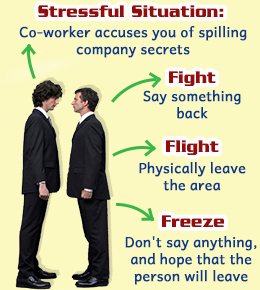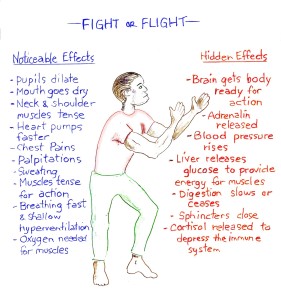Seriously; after watching that short video, how many times have you ever found yourself in traffic and you’re running late and you can’t seem to get anyone on the road to MOVE out of your way? Or you seem to hit every red light on your journey and think what a waste of time it was to just sit there? How about that time that your debit card got declined in the grocery line?
I’m sure most of you have experienced some type of anxiety that just makes your blood boil. I actually know people that cannot control their fight or flight response to such a point that they could be prime candidates for high blood pressure, heart problems and more!
Let’s explain why this happens and what your anxious reaction to these occurrences in your life actually does to your body.
Our response to these types of situations is called the fight-or-flight response, also known as the acute stress response, and refers to a physiological reaction that occurs in the presence of something that is terrifying, either mentally or physically. The response is triggered by the release of hormones that prepare your body to either stay and deal with a threat or to run away to safety.
The fight-or-flight response was first described in the 1920s by American physiologist Walter Cannon.
Cannon realized that a chain of rapidly occurring reactions inside the body help mobilize the body’s resources to deal with threatening circumstances.
How does it work?
**A threat is perceived
**The autonomic nervous system automatically puts body on alert.
**The adrenal cortex automatically releases stress hormones.
**The heart automatically beats harder and more rapidly.
**Breathing automatically becomes more rapid.
**Thyroid gland automatically stimulates the metabolism.
**Larger muscles automatically receive more oxygenated blood.
The important thing to take away is that the fight or flight response is an automatic response.
Now here’s where this great automatic response needs to be controlled by us!
False alarms!
Even though the fight or flight response is automatic, it isn’t always accurate. In fact most of the time when the fight or flight response is triggered it is a false alarm – there is no threat to survival. The part of the brain the initiates the automatic part of the fight or flight response, the amygdala, can’t distinguish between a real threat and a perceived threat. You’re not going to die if you sit at that red light for 3 minutes! Or yelling at everyone in traffic surely won’t get it to move any faster.
Chill, no, freeze!
Sometimes the perceived threat is so intense it triggers a “freeze” response. This could be interpreted as the brain being overwhelmed by the threat, or it could also be an adaptive / positive response to a threat. It probably evolved in humans and animals as a way of “keeping still” so a predator’s attention would not be triggered by movement.
Either way, for modern humans the freeze response means that the muscles remain tensed and poised for action….action that is never really initiated. That’s why we often get “knots” in our backs, shoulders, neck, and arms. We have not discharged the tension.
In most cases today, once our fight or flight response is activated, we cannot flee. We cannot fight. We cannot physically run from our perceived threats. When we are faced with modern day, saber tooth tigers, we have to sit in our office and “control ourselves.” We have to sit in traffic and “deal with it.” We have to wait until the bank opens to “handle” the bounced check. In short, many of the major stresses today trigger the full activation of our fight or flight response, causing us to become aggressive, hypervigilant and over-reactive. This aggressiveness, over-reactivity and hypervigilance cause us to act or respond in ways that are actually counter-productive to our survival. Consider road rage in Los Angeles and other major cities.
It is counterproductive to punch out the boss (the fight response) when s/he activates our fight or flight response. (Even though it might bring temporary relief to our tension!) It is counterproductive to run away from the boss (the flight response) when s/he activates our fight or flight response. This all leads to a difficult situation in which our automatic, predictable and unconscious fight or flight response causes behavior that can actually be self-defeating and work against our emotional, psychological and spiritual survival.
Suppose on Saturday afternoon you go to the grocery store. You have a cart full of food and when you go to pay with your ATM card, it is declined. You don’t understand, you made a deposit just yesterday and there should be money in your account. Your heart starts beating wildly, you are stunned. Your fight or flight has been activated. You decide to run (by walking out of the store embarrassed), but you haven’t solved the problem. You can fight but with who? The cashier only knows your card has been declined, she has no way of checking the balance or activity on the account. The bank is closed until Monday. Instead you are left with a feeling of apprehension for two days. Your fight or flight response remains, you stay on high alert for two days. When your fight or flight response has been activated, everything in your surroundings becomes a potential threat. You spend the weekend jumpy and agitated. Since the fight or flight response diverts blood and resources away from your digestive tract, you don’t eat much (which is good since you couldn’t buy food). Your adrenaline is pumping, so you don’t sleep much. By Monday morning, you are angry and go to the bank ready to fight.
In the past, when we were confronted with fears like lions and tigers and bears (oh,my), the danger was immediate and usually passed relatively quickly. Our fight and flight was activated, helped us and then was deactivated. In today’s world, it doesn’t always deactivate as you can see from the above example.
Some experts believe people with anxiety have a hypersensitive fight or flight response. That is, it activates without much provocation or with no provocation at all. Even a perceived danger can make you go into full blown fight or flight. Once you do, everything around you becomes a possible danger and you become overly anxious. You see the world as a fearful place. You are stuck in “survival mode.”
The best part about learning all of this is that we now will recognize the symptoms and signs of being in the ‘fight-or-flight’ and begin to take steps to overcome the stress overload.
It served our ancestors well, but it has a cost. Staying physiologically on guard against a threat eventually wears down the body’s natural defenses. In this way, suffering from frequent stress —or frequently interpreting experiences as stressful —can create a serious health risk: an essentially healthy stress response can become distress.
So what we’ve learned here basically is to
STAY CALM AND REMAIN HEALTHY!
Valerie





